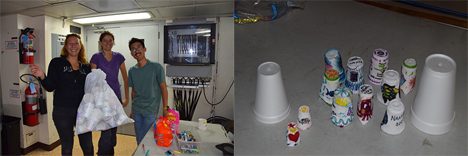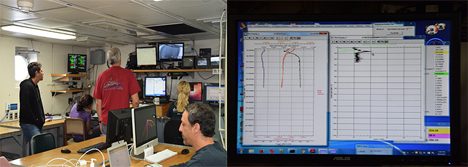Most of us think that our everyday lives put us under pressure, but the real pressure – in a physical sense – happens deep below the ocean surface. On Friday, most of us in the NAAMES III science teams aboard the Atlantis performed an exercise that clearly demonstrates that pressure. The ship is always buzzing with science activities, but that day there was a different buzz, as all of us took breaks from our sampling routines and, as excited as little kids, grabbed markers of multiple colors to actively decorate Styrofoam cups with our favorite motifs, all the while chewing on candies. True to oceanographic tradition, the decorated cups would then be sent down to 3000 m below the ocean surface. Due to the pressure, when the cups come back up they have shrunk to a fraction of their original size. Many of the designs on the cups were inspired by ocean creatures, or by the sunsets and sunrises and the beautiful skies that we had been admiring from the ship. Favorite sports teams were also featured, as of course were the R/V Atlantis and the NASA planes that fly above our sampling region. We take the shrunken cups home as souvenirs of our time on the ocean.

SSSG Catie attaching cups to the CTD on board the R/V Atlantis
The cups go down securely attached to a sampling package made of various sensors and water sampling bottles known as a CTD, which is cast from the ship via a winch. CTD is an essential oceanographic instrument that occupies a central place in the NAAMES field campaigns. CTD is an acronym for conductivity, temperature, and depth, which are among the primary parameters that the instrument measures and give information about the physical structure of the ocean in the vertical dimension. Attached to the CTD are also probes that measure parameters such as oxygen and fluorescence. Fluorescence is caused by the dissipation of some of the energy contained in the light absorbed by pigments, such as chlorophyll, occurring within ocean microscopic plants known as phytoplankton. A portion of the absorbed light is emitted at another (longer) wavelength, stimulating fluorescence that can be measured by the probe, providing an estimate of the concentration of the phytoplankton.

NAAMES scientists with their decorated cups (left) and the shrunken cups after going down to 3000m (right)
As the CTD is cast downwards, the data its sensors collect are displayed in real time on a computer screen, attracting many of us around the computer avidly watching vertical profiles of the ocean.

The CTD room on board the R/V Atlantis (on the left) and typical CTD profile display (on the right).
We use the information to determine which depths present interesting features that will guide our sampling. On the up cast, the CTD can then be stopped at these specific depths to collect water that provides chemical and biological samples and is also used in experiments. Even if we find decorating Styrofoam cups fun, that is when we go back to our lab with the collected water that the true fun begins.
Written by Francoise Morison
Tags: NAAMES-III 2017



